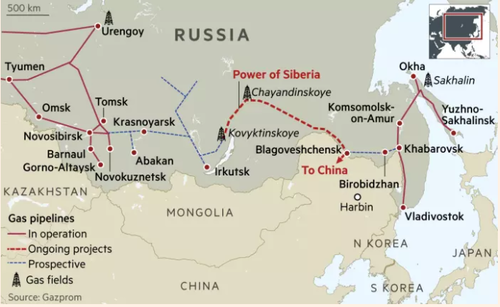Russia Pipeline Gas Flows To China Have Increased Since The Ukraine War
Russia has increased gas supply to China via its Power of Siberia pipeline after its invasion of Ukraine began, ENN Energy CFO Liu Jianfeng said on the company’s earnings call. ENN is one of China’s largest city gas utlities and purchases gas from oil majors including China National Petroleum Corp, which operates the import pipeline on its side of the border.
The Power of Siberia pipeline ships gas from eastern Russia into northern China, and is ramping up over several years to maximum capacity of 38 bcm/year. The Power of Siberia pipeline began pumping supplies in 2019; Russia is also shipping liquefied natural gas (LNG) to China. It exported 16.5 billion cubic metres (bcm) of gas to China in 2021.
The Power of Siberia network is not connected to pipelines that send gas to Europe, which has faced surging gas prices due to tight supplies, one of several points of tension with Moscow. Under plans previously drawn up, Russia aimed to supply China with 38 bcm of gas by pipeline by 2025.
Meanwhile, Gazprom, which has a monopoly on Russian gas exports by pipeline and which operates the Russian side of the pipeline, said Tuesday that exports to China continue to grow under its bilateral long-term agreement with CNPC. Flows had been increasing before the invasion, as well, with Gazprom saying in mid-February it had just set a daily record for exports to China on the pipeline.
One month ago, Russia agreed a 30-year contract to supply gas to China via a new pipeline and will settle the new gas sales in euros, bolstering an energy alliance with Beijing amid Moscow’s strained ties with the West over Ukraine and other issues. Gazprom agreed to supply Chinese state energy major CNPC with 10 billion cubic metres of gas a year, the Russian firm and a Beijing-based industry official said.
First flows through the pipeline, which will connect Russia’s Far East region with northeast China, were due to start in two to three years, the source said in comments that were later followed by an announcement of the deal by Gazprom. The new deal, which coincided with a visit by Russian President Vladimir Putin to the Beijing Winter Olympics, would add a further 10 bcm, increasing Russian pipeline sales under long-term contracts to China.
Russian gas from its Far East island of Sakhalin will be transported via pipeline across the Japan Sea to northeast China’s Heilongjiang province, reaching up to 10 bcm a year around 2026, said the Beijing source, who asked not to be identified. The deal would be settled in euros, the source added, in line with efforts by the two states to diversify away from U.S. dollars.
Discussions between the two firms began several years ago after the start-up of Power of Siberia, a 4,000-km (2,500-mile)pipeline sending gas to China. Talks accelerated more recently after Beijing set its 2060 carbon neutral goal, the source said.
“China’s coal shortage last year served as another wake-up call that natural gas has its special value, that’s why CNPC decided to top up with the new pipeline deal,” the source said.
The pricing of the new gas deal will be similar to that of Power of Siberia, the source said, adding that both were “fairly satisfied” with that arrangement.
The deal is expected to weigh on China’s LNG import outlook. “Piped gas from Russia can be supplied to northern China at prices that are competitive when compared with LNG,” said Ken Kiat Lee, analyst at consultancy FGE.
Meanwhile, as Russian gas exports to China increase, those headed for Europe have slowed, and in some cases such as the Yamal-Europe pieline, been largely shut for much of 2022.
Tyler Durden
Fri, 03/18/2022 – 23:20

